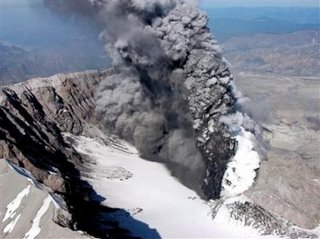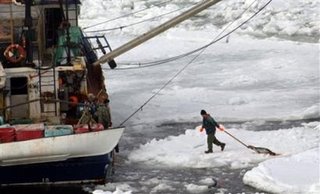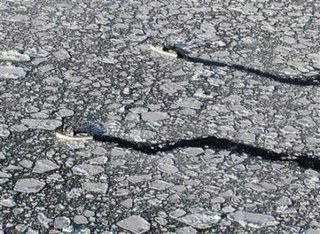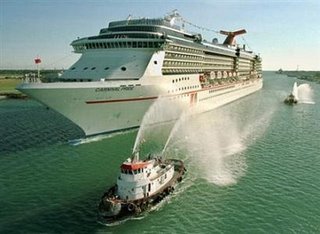A child plays in an uprooted tree after Cyclone Larry destroyed much of Innisfail, 22 March 2006. Prisoners with building and other trade skills will be used to assist in the clean-up of areas of north-eastern Australia hit by the devastating tropical, a government official said(AFP/File/Torsten Blackwood)
A car drives through a battered rain forest at Mission Beach Friday, March 24, 2006. Cyclone Larry hit Monday March 20, 2006, packing winds up to 300 kph (185 mph), ripping roofs off buildings across Australia's northeastern coast but also devastating the age old rain forests in the region. This rain forest is habitat for thousands of bird and animal species, including the critically endangered cassowary. The Queensland Parks and Wildlife Service estimates that fewer than 1,500 of the large, blue-headed, emu-like birds remain in the wild and wildlife workers worry the birds now won't have enough to eat for a while. (AP Photo/Rob Griffith)

The remains of a public telephone booth stand on the main street of the cyclone-damaged town of Silkwood, about 100 kilometres (62 miles) south of Cairns March 24, 2006. Restoring power to Australia's storm-devastated far northeast coast is the main concern, Prime Minister John Howard said on Thursday as survivors of powerful Cyclone Larry began giving vent to frustrations. REUTERS/Tim Wimborne
Power poles that were damaged by Cyclone Larry lean at angles on a residential street of Innisfail, about 80 km (48 miles) south of Cairns, March 24, 2006. Restoring power to Australia's storm-devastated far northeast coast is the main concern, Prime Minister John Howard said as survivors of powerful Cyclone Larry began giving vent to frustrations. REUTERS/Tim Wimborne
A power pole that was damaged by Cyclone Larry leans at an angle on a residential street of Innisfail, about 80 km (48 miles) south of Cairns, March 24, 2006. Restoring power to Australia's storm-devastated far northeast coast is the main concern, Prime Minister John Howard said as survivors of powerful Cyclone Larry began giving vent to frustrations. REUTERS/Tim Wimborne
Cartwright Road disappears under flood water near Innisfail, about 100 kilometres (60 miles) south of Cairns March 23, 2006. Restoring power to Australia's storm-devastated far northeast coast is the main concern, Prime Minister John Howard said on Thursday as survivors of powerful Cyclone Larry began giving vent to frustrations. REUTERS/Tim Wimborne
Storm clouds gather over graves and trees damaged by Cyclone Larry at Innisfail cemetery, about 80 kilometres (49 miles) south of Cairns March 23, 2006. Restoring power to Australia's storm-devastated far northeast coast is the main concern, Prime Minister John Howard said on Thursday as survivors of powerful Cyclone Larry began giving vent to frustrations. REUTERS/Tim Wimborne
An Australian military helicopter flies over the cyclone damaged town of Silkwood, about 100 kilometres (60 miles) south of Cairns March 23, 2006. Restoring power to Australia's storm-devastated far northeast coast is the main concern, Prime Minister John Howard said on Thursday as survivors of powerful Cyclone Larry began giving vent to frustrations. REUTERS/Tim Wimborne
Cyclone damaged power poles stand at various angles in a street in the northern Queensland town of Innisfail 84 kilometers (52 miles) from Cairns, Thursday, March 23, 2006. Cyclone Larry ripped roofs off buildings across Australia's northeastern coast Monday March 20, packing winds up to 290 kph (180 mph), leaving an unknown number of people homeless but causing only a handful of minor injuries. Innisfail was hardest hit by the cyclone disrupting power, water and sewage in the region. (AP Photo/Mark Baker)
A house damaged by a tree blown over by Cyclone Larry in Innisfail, about 100 km (62 miles) south of Cairns, is visible from the air, March 22, 2006. Thousands of Australians on the cyclone-devastated far northeast coast patched up homes with tarpaulin on Wednesday as Prime Minister John Howard unveiled a multi-million dollar aid package. REUTERS/Tim Wimborne
Banana trees destroyed by Cyclone Larry lie on the ground near Babinda, about 80 km (48 miles) south of Cairns in Northern Queensland March 22, 2006. Thousands of Australians on the cyclone-devastated far northeast coast patched up homes with tarpaulin on Wednesday as Prime Minister John Howard unveiled a multi-million dollar aid package. REUTERS/Tim Wimborne
Clayton, right, and Matthew Hoy wade through flood waters surrounding their family home outside Innisfail, 84 kilometers (52 miles) from Cairns, Wednesday, March 22, 2006. The Hoy family farm, a 100-acre banana plantation, was destroyed by Cyclone Larry and then flooded by heavy rains, which where hampering the relief effort and clean up procedures. The category 5 storm, which hit Monday, ripped roofs off buildings across Australia's northeastern coast packing winds up to 290 kph (180 mph), leaving an unknown number of people homeless. Innisfail was hardest hit by the cyclone. (AP Photo/Rob Griffith)

Debris surrounds houses after a cyclone hit the northern Queensland town of Innisfail, 84 kilometers (52 miles) of Cairns, Australia, Tuesday, March 21, 2006. Cyclone Larry ripped roofs off buildings across Australia's northeastern coast packing winds up to 290 kph (180 mph), leaving an unknown number of people homeless but causing only a handful of minor injuries. Innisfail was hardest hit by the cyclone disrupting power, water and sewage in the region. (AP Photo/Mark Baker)
A satellite photo made available by the Australian Bureau of Meteorology shows Cyclone Larry over northeastern Australia. Troops are heading for cyclone-devastated northeast Australia, as Prime Minister John Howard pledged quick aid for those left homeless or without power by the country's worst storm in decades(AFP/HO)
A house lies completely destroyed in the northern Queensland town of Innisfail, 84 kilometers (52 miles) from Cairns, Tuesday, March 21, 2006. Cyclone Larry ripped roofs off buildings across Australia's northeastern coast packing winds up to 290 kph (180 mph), leaving an unknown number of people homeless but causing only a handful of minor injuries. Innisfail was hardest hit by the cyclone disrupting power, water and sewage in the region. (AP Photo/Mark Baker)
A man looks into destroyed shops on the main street of Innisfail in northern Queensland, 84 kilometers (52 miles) from Cairns Tuesday, March 21, 2006. Cyclone Larry ripped roofs off buildings across Australia's northeastern coast packing winds up to 290 kph (180 mph), leaving an unknown number of people homeless but causing only a handful of minor injuries. Innisfail was hardest hit by the cyclone disrupting power, water and sewage in the region.(AP Photo/Rob Griffith)


















































